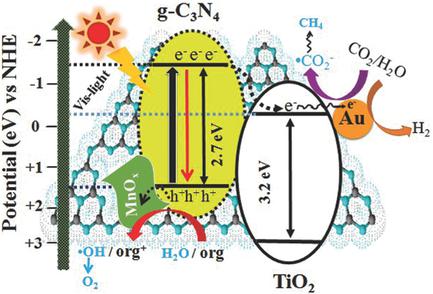当前位置:
X-MOL 学术
›
Adv. Energy Mater.
›
论文详情
Our official English website, www.x-mol.net, welcomes your
feedback! (Note: you will need to create a separate account there.)
Synthesis of Large Surface‐Area g‐C3N4 Comodified with MnOx and Au‐TiO2 as Efficient Visible‐Light Photocatalysts for Fuel Production
Advanced Energy Materials ( IF 24.4 ) Pub Date : 2017-09-21 , DOI: 10.1002/aenm.201701580 Fazal Raziq 1 , Liqun Sun 1, 2 , Yuying Wang 1 , Xuliang Zhang 1 , Muhammad Humayun 1 , Sharafat Ali 1 , Linlu Bai 1 , Yang Qu 1 , Haitao Yu 1 , Liqiang Jing 1
Advanced Energy Materials ( IF 24.4 ) Pub Date : 2017-09-21 , DOI: 10.1002/aenm.201701580 Fazal Raziq 1 , Liqun Sun 1, 2 , Yuying Wang 1 , Xuliang Zhang 1 , Muhammad Humayun 1 , Sharafat Ali 1 , Linlu Bai 1 , Yang Qu 1 , Haitao Yu 1 , Liqiang Jing 1
Affiliation

|
Herein, this study successfully fabricates porous g‐C3N4‐based nanocomposites by decorating sheet‐like nanostructured MnOx and subsequently coupling Au‐modified nanocrystalline TiO2. It is clearly demonstrated that the as‐prepared amount‐optimized nanocomposite exhibits exceptional visible‐light photocatalytic activities for CO2 conversion to CH4 and for H2 evolution, respectively by ≈28‐time (140 µmol g−1 h−1) and ≈31‐time (313 µmol g−1 h−1) enhancement compared to the widely accepted outstanding g‐C3N4 prepared with urea as the raw material, along with the calculated quantum efficiencies of ≈4.92% and 2.78% at 420 nm wavelength. It is confirmed mainly based on the steady‐state surface photovoltage spectra, transient‐state surface photovoltage responses, fluorescence spectra related to the produced •OH amount, and electrochemical reduction curves that the exceptional photoactivities are comprehensively attributed to the large surface area (85.5 m2 g−1) due to the porous structure, to the greatly enhanced charge separation and to the introduced catalytic functions to the carrier‐related redox reactions by decorating MnOx and coupling Au‐TiO2, respectively, to modulate holes and electrons. Moreover, it is suggested mainly based on the photocatalytic experiments of CO2 reduction with isotope 13CO2 and D2O that the produced •CO2 and •H as active radicals would be dominant to initiate the conversion of CO2 to CH4.
中文翻译:

MnOx和Au-TiO2共修饰的大表面积g-C3N4的合成为燃料生产的高效可见光光催化剂
本文中,这项研究通过装饰片状纳米结构MnO x并随后偶联Au改性的纳米晶TiO 2,成功地制造了基于g-C 3 N 4的多孔纳米复合材料。清楚地表明,所制备的量优化的纳米复合材料在≈28倍(140 µmol g -1 h -1)和约28倍的CO 2转化为CH 4以及H 2的析出方面表现出优异的可见光光催化活性。与公认的出色g-C 3 N 4相比,增强了≈31倍(313 µmol g -1 h -1)以尿素为原料制备,在420 nm波长下计算出的量子效率分别为≈4.92%和2.78%。主要根据稳态表面光电压光谱,瞬态表面光电压响应,与产生的•OH量有关的荧光光谱和电化学还原曲线证实,优异的光活性综合归因于大表面积(85.5 m 2 g -1)归因于其多孔结构,极大地增强了电荷分离并通过装饰MnO x和偶联Au‐TiO 2引入了与载体有关的氧化还原反应的催化功能分别调制空穴和电子。此外,主要基于同位素13 CO 2和D 2 O的CO 2还原的光催化实验表明,所产生的•CO 2和•H作为活性基团将主导引发CO 2向CH 4的转化。
更新日期:2017-09-21
中文翻译:

MnOx和Au-TiO2共修饰的大表面积g-C3N4的合成为燃料生产的高效可见光光催化剂
本文中,这项研究通过装饰片状纳米结构MnO x并随后偶联Au改性的纳米晶TiO 2,成功地制造了基于g-C 3 N 4的多孔纳米复合材料。清楚地表明,所制备的量优化的纳米复合材料在≈28倍(140 µmol g -1 h -1)和约28倍的CO 2转化为CH 4以及H 2的析出方面表现出优异的可见光光催化活性。与公认的出色g-C 3 N 4相比,增强了≈31倍(313 µmol g -1 h -1)以尿素为原料制备,在420 nm波长下计算出的量子效率分别为≈4.92%和2.78%。主要根据稳态表面光电压光谱,瞬态表面光电压响应,与产生的•OH量有关的荧光光谱和电化学还原曲线证实,优异的光活性综合归因于大表面积(85.5 m 2 g -1)归因于其多孔结构,极大地增强了电荷分离并通过装饰MnO x和偶联Au‐TiO 2引入了与载体有关的氧化还原反应的催化功能分别调制空穴和电子。此外,主要基于同位素13 CO 2和D 2 O的CO 2还原的光催化实验表明,所产生的•CO 2和•H作为活性基团将主导引发CO 2向CH 4的转化。











































 京公网安备 11010802027423号
京公网安备 11010802027423号